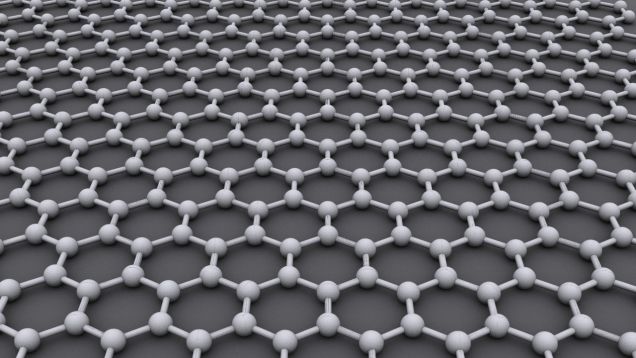Graphene, the wonder material for a new industrial revolution?
 Graphene has the reputation to be able to transform a range of sectors such as electronics, energy, health and construction, to revolutionize the fields in which they are applied. Many experts claim that graphene has the potential to become the material of the 21st century.
Graphene has the reputation to be able to transform a range of sectors such as electronics, energy, health and construction, to revolutionize the fields in which they are applied. Many experts claim that graphene has the potential to become the material of the 21st century.
Not a month passes without media and blogosphere reports on the “new wonder material”(1)
Graphene properties
- Graphene has almost magic properties
- electrical conductivity superior to copper
- 200 times stronger than steel but six times lighter
- only absorbs 2% of light – almost perfectly transparent
- impermeable to gases, even to the smallest ones such as hydrogen or helium
- it can alter its properties by chemical derivatization on the surface
These magic properties of graphene are the reason why scientists see enormous potential for future applications of graphene.
Applications for the new “wonder material”
Various science and technology fields could potentially face disruptive changes due to future graphene applications. A very comprehensive summary was given by Ferrari et al. (2) who laid out the European roadmap for graphene science and technology (3).
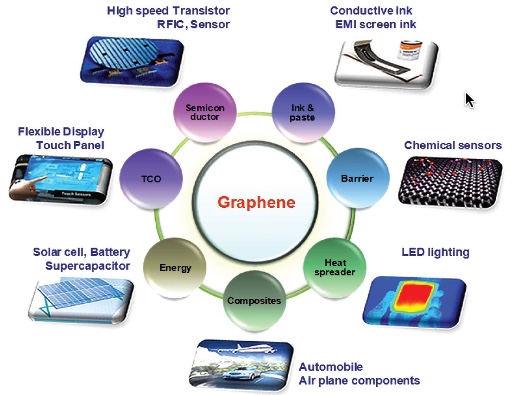
The science and technology fields related to graphene include health and environment, production, sensors, flexible electronics, energy conversion and storage, composite materials, biomedical devices, and electronic devices, including spintronics, photonics and optoelectronics.
To understand the „magic“ properties of the new material one has to look at the chemical structure of the material.
The structure of graphene
Graphene is a modification of carbon, a two dimensional network of carbon atoms.
Carbon has various modifications: The most prominent ones are diamond and graphite. Graphene is a single layer of graphite (see the appendix for structural details of diamond and graphite).
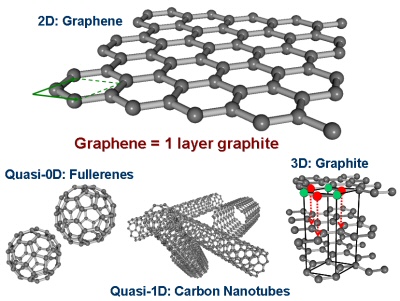
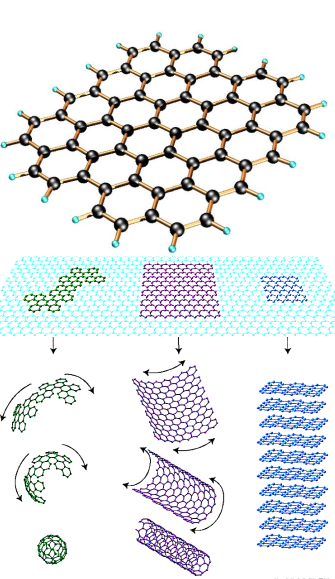
Basically, by taking off one single layer of graphite, graphene is obtained. The carbon atoms in graphene are bound within a plane by chemical bonds into an array comprised of six-membered rings (benzene rings).
Graphene is also closely related to carbon nanotubes and fullerenes. By stacking layers of graphene, the well known three dimensional graphite structure is obtained. Carbon nanotubes are formed by rolling up graphene sheets. And by adding five-membered rings it is possible to form fullerenes, football shaped structures, of which the most prominent one is the Buckminsterfullerene C60.
The picture (from a presentation of Oak Ridge National Laboratory) illustrates the structural relationship of fullerenes, carbon nanotubes and graphite (from left to right) which are all based on graphene as building block.
History of the graphene discovery
Graphene, the miracle material, has come a long way. For a long time, scientists believed that such a two-dimensional structure would be unstable and roll up, as observed in the 1990s with carbon nanotubes and fullerenes. Only as late as in 2004, two Russian-born scientists, Andre Geim and Konstantin Novoselov of the University of Manchester in the UK, published evidence for the isolation of graphene. Geim and Novoselov won the Nobel prize for physics in 2010 for their brilliant discovery (5).
Quality, synthesis and manufacturing
So far, it is inefficient to manufacture graphene in mass quantities, especially when high-quality material is required.
The required quality, measured in units of cm2/(V s), primarily depends on the the desired application.
The quality of graphene plays a crucial role for applications as the presence of defects,
structural disorders, impurities, grain boundaries, multiple domains, and wrinkles in the graphene sheet has an impact on its electronic and optical properties.
The most popular methods for manufacturing of graphene are
- exfoilation from graphite
- chemical-vapor-deposition (CVD)
As its name indicates, graphene can be extracted from graphite since it is a layer of graphite. The “exfoliated graphene method” first used to produce graphene in 2009 created the highest quality graphene, at 200.000 cm2/(V s). However, exfoliation seems to be not well suitable for bulk quantities.
The chemical-vapor-deposition (CVD) method is commonly used to manufacture graphene.
The chemical-vapor-deposition (CVD) method works by heating a copper chamber to high temperatures around 1.000 degrees Celsius, exposing it to methane (CH4) which provides the source of carbon, and letting graphene form on the surface of the copper.
The material created by CVD is of comparably low quality, measured only about 2.000 cm2/(V s), partly due to imperfections in the copper. The process for CVD has since been refined to about 30.000 cm2/(V s), but over the course of nine hours and burning consistently at high temperatures. That’s not terribly efficient.
Not a month passes without media and blogosphere reports on scientific announcements of alleged breakthroughs in production technologies, for example a modified CVD method by Caltech claiming improved quality of 60.000 cm^2/(V s) (6), by Oak Ridge National Laboratory (7) and MIT´s continuous roll-to-roll process (8).
We will publish in this blog in future more articles on the progress and specific examples of graphene production technology.
Patent and publication landscape
The number of patents and publications on graphene is growing exponentially. Corporations and universities have a significant foothold in the graphene IP landscape which provides significant opportunities to secure future value.
Patent applications are driven by major corporations and universities in the US, Europe, China and South Korea. In particular, the Korean company Samsung holds a very significant patent portfolio.
A detailed analysis of the patent and publication landscape are included in recent of Ferrari et al. (2) and on the nanowerk website (status 2012) (9).
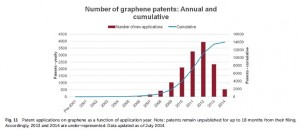
Summary
Graphene is the most promising new development of material sciences, due to its unique combination of properties, which opens a way for exploitation in a wide spectrum of applications.
Yet there are many obstacles for the commercial exploitation of this new nano material. One of the greatest challenges today in commercializing graphene is how to manufacture high quality material, on a large scale, at commercially acceptable cost.
Appendix: Modifications of carbon
Graphite, the material used in pencils, is the most stable form of carbon under standard conditions. It has a layered, planar structure. In each layer, the carbon atoms are arranged in a planar honeycomb lattice, each carbon atom being sp2 hydridized and every carbon atom bound to 3 other carbon atoms.
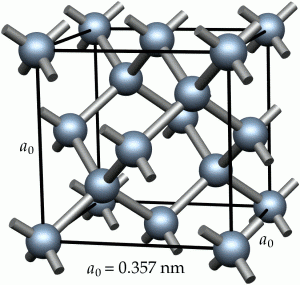
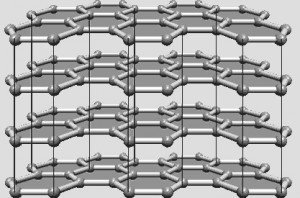

References
(1) Graphene – the new wonder material, The Guardian
(2) Ferrari et al., Science and technology roadmap for graphene, related two-dimensional crystals, and hybrid systems, Nanoscale 7, 4598 (2015)
(3) The European roadmap for graphene science and technology
(4) Graphene: a new electronics material (Uni Erlangen)
(5) Graphene Researchers Geim and Novoselov Win Nobel Prize in Physics
(6) This Scientist Invented a Simple Way to Mass-Produce Graphene
(7) Graphene production breakthrough declared (again)
(8) MIT researchers pioneer technique for mass-producing graphene
(9) Mass production of high quality graphene: An analysis of worldwide patents

